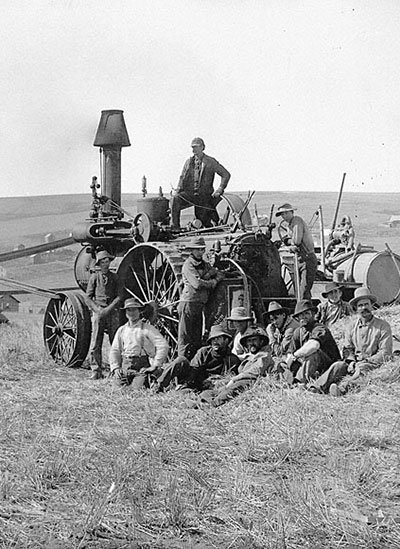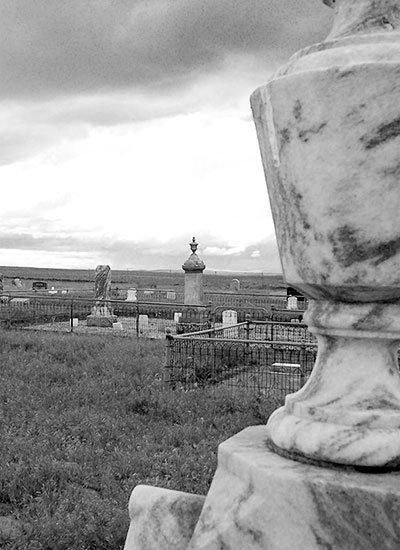In The Golden Land, Giles French describes this place: “ The land that lies between the Deschutes and John Day rivers and north of township five south of the base line in Oregon is Sherman County. It slopes gently north to the Columbia River on what is called by geologists the Shaniko surface… Because of the deep gorges of the Deschutes and John Day rivers running north to the Columbia, Sherman County is a geological and geographical entity. The canyons make it to a marked extent a social and political entity as well.
“… The general slope is to the north. Elevations along the Columbia river are about 120 feet above sea level and on the southern boundary the elevations are around 3,000 feet. Town elevations gradually rise as one travels south from the Columbia, Wasco 1,271, Moro 1,807, Grass Valley 2,269, Kent 2,709… There are smaller drainage areas within the county, the greatest of them flowing toward the John Day River. Hay Canyon, Grass Valley Canyon, Pine Hollow and Ferry Canyon all run into the John Day. Only the bordering Buck Hollow of the major water courses flows into the Deschutes… The prevailing wind is west and southwest…”
“The settlers on the Sherman County hills developed an
independent streak shortly after getting located …
The spirit of independence… ownership of land…
led to a desire to have a new county all of their own.”
— Giles French
The formation of the county to be named Fulton for Col. James Fulton, pioneer settler and legislator, was proposed by ElihuOwen McCoy, a Wasco County legislator. Sherman County was created by legislative action in 1889 and, by default, named for General William Tecumseh Sherman.
This description was published in General Laws of 1889, p. 82; Frederick Holman, Oregon Counties, Oregon Historical Society Quarterly XI-1, 1910: “Beginning at a point in the main channel of the Columbia river, opposite the mouth of said John Day river; thence up the middle of the main channel of the John Day river to the south line of township 2 south where it crosses the said John Day river; thence west along the said south line of township 2 to the middle of the Deschutes river; thence down the center of the main channel of said river to a point in the center of the main channel of the Columbia river opposite to the mouth of the Deschutes river; thence up the middle of the main channel of the Columbia river to the place of beginning.”Wasco was chosen to be the county seat that year. The first marriage in the new county was that of S.B. Walter and Emily Larison in 1889.
In 1890, 1,792 people lived in Sherman County, including eight “civilized Indians” and 25 Chinese. There were 431 dwellings, 441 families, 4.16 persons to a dwelling and 4.06 persons to a family. There were 427 native white males, 127 foreign white males and 30 colored males, all 21 years of age or over. Counted by precinct: 84 people in Biglow, 39 Biglow Springs, 300 Grant, 283 Monkland, 243 Moro and 657 Moro.
Sherman County’s boundary was stretched 18 miles by the legislature in 1890. The election to establish a county seat failed with no clear choice between Wasco, Kenneth and Moro.
In 1892, the second attempt to establish a county seat resulted in Wasco 301 – Moro 404. There were 2,511 legal voters in 1895 and in 1899 the courthouse was built for $6,665, the year Moro was incorporated.
By 1900 the population was 3,467 with nearly 660 town residents and about 2,800 on farms. A 1905 state census shows 4,884 persons. An Official Summaryas compiled by Assessor Otto Peetz was published in the Sherman County Observer, September 8, 1905: Population by precincts: Wasco 1,031, Moro 727, Grass Valley 707, Kent 511, Monkland 287, Rufus 262, Bigelow [sic] 180 and Rutledge 177 for a total of 3,882. Population by cities: Wasco 498, Moro 446, Grass Valley 383 for a total of 1,327.
The 1910 population was 4,242, the largest ever. The 1930 count was 2,978 and in 1950 2,271.
Sources: General Laws of 1889, p. 82; Frederick Holman, Oregon Counties, OHS Quarterly XI-I, 1910; Sherman County: For The Record vol. 2-1; Giles French; McArthur, Oregon Geographic Names; The Compendium of the Eleventh Census, 1890, pub. 1892; Sherman County 1905 Census: An Official Summary as compiled by Assessor Otto Peetz for the Sherman County Observer, September 8, 1905; Douthit, The Dalles Times-Mountaineer, Resources of Wasco and Sherman Counties, 1898.
Explore the county through the words of the 1989 Sherman County Centennial Committee, stories of settlers, homesteaders, stockmen and life in early Sherman County.
“The settlers on the Sherman County hills developed an independent streak shortly after getting located … The spirit of independence… ownership of land… led to a desire to have a new county all of their own.”” — Giles French
A compilation of notes and tidbits regarding the businesses of Sherman County, Oregon. Delve into lists of leading taxpayers, liquor license petitions, Tidbits from The Observer newspaper, and details of the 1902 Horse Fair just to name a few.
MoreAn interest in family history and genealogy led me to local cemeteries for my personal records. In 1965 I conducted a survey of county cemeteries, collecting names and dates from gravestones and talking to county elders. The Genealogical Forum of Oregon published these records in Yesterday’s Roll Call with those of two other counties in 1970.
MoreMy interest in church history began when I learned that my great-grandparents, James and Margaret (Dougherty) Woods, were charter members of the Moro Presbyterian Church where I attended Sunday school. After joining the Methodist church in Wasco, I transcribed very early church circuit records and, with others, printed a few copies on a Mimeograph machine, our contribution to the annual fundraising bazaar. We called it Gleanings.
More Sherman County: For The Record
Sherman County: For The Record
Sherman County: For The Record is the twice-yearly historical anthology published by the Sherman County Historical Society in Moro, Oregon. It is one of the benefits of Society membership. The many authors who contributed to For The Record provide a window into the past with memoirs, official records, and wonderful photographs. Memorial contributions to the Society are published in each issue.
MoreResearch into family history and genealogy led me to courthouses in search of deeds and records of births, marriages, divorce, death, wills and probate. With the advent of the Internet, public records on-line brought a new world of discovery: census and public records across the land!
MoreAs a volunteer Sherman County Historical Museum volunteer producing an exhibit, Patriotism: Pride & Anguish, curiosity and scholarship led me to learn more about the artifacts, Sherman County people who served, conflicts here and abroad, and the World War II Camp Rufus bridging exercises at Rufus.
MoreWhen my family moved to Moro in 1942, the Sherman County Journal shop was on the route to the confectionery and the grocery store. A school assignment to interview the editor/publisher and others for a report on the history of Moro took me inside the shop where I met Giles and Lela French. Years later we shared our interests in local history and I was encouraged to explore beyond family history. As I volunteered as an editor for the historical society publication, Sherman County: For The Record, with Patty Moore, and later with Chris Sanders, I loved our research in the old newspapers. Highly recommended: Visit the museum to enjoy the exhibit, Sherman County Journal: Paper, Ink & Presses!
More Notes, Stories and Interesting items
Notes, Stories and Interesting items
History is a giant story that leads to you! These brief notes, stories and facts are noteworthy reminders of those who came to Sherman County. Their stories help us to understand society and the events and people that shaped our county, farms and towns.
History offers us a sense of identity. When asked where we live, we often say an inclusive, “Sherman County.” The stories of those who came in the early years may inspire us to take action in our own lives. They certainly give us an understanding and perspective of the hard work, challenges, adventures, loss and achievements that led to the present.
MorePlaces! This word evokes questions! Where? When? Why? What happened? Maps? I was surprised to learn about these little-known places. Some are on private property. No trespassing, please.
MoreMy beloved 5th and 6th grade teacher, Grace (May) Zevely, opened doors for me with maps, geography, and pen pals. She taught the town kids leather and copper tooling at her house and accompanied us on walk-abouts in Moro. She, along with Bertha Belshe, gathered a great deal of information about the country schools. See Sherman County: For The Record, vols. 6-2, 20-2 and 22-1.
MoreTime-lines or milestones for the county, the county fair and the historical society, offer inspiration and historical value essential for research.
MoreEarly newspapers and directories offer descriptions and statistics for our towns almost from their beginnings. The Sherman County Historical Society published several town stories and other stories with mention of our towns in Sherman County: For The Record 1983-2016.
MoreGoogle Maps
Explore Sherman County, Oregon through Google Maps!
I am tired and sick of war. Its glory is all moonshine. It is only those who have neither fired a shot nor heard the shrieks and groans of the wounded who cry aloud for blood, for vengeance, for desolation. War is hell. – William Tecumseh Sherman











